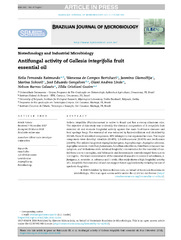Приказ основних података о документу
Antifungal activity of Gallesia integrifolia fruit essential oil.
| dc.creator | Raimundo, Keila Fernanda | |
| dc.creator | Bortolucci, Wanessa de Campos | |
| dc.creator | Glamočlija, Jasmina | |
| dc.creator | Soković, Marina | |
| dc.creator | Gonçalves, José Eduardo | |
| dc.creator | Linde, Giani Andrea | |
| dc.creator | Colauto, Nelson Barros | |
| dc.creator | Gazim, Zilda Cristiani | |
| dc.date.accessioned | 2018-05-17T09:23:19Z | |
| dc.date.available | 2018-05-17T09:23:19Z | |
| dc.date.issued | 2018 | |
| dc.identifier.uri | https://www.sciencedirect.com/science/article/pii/S1517838217310651?via%3Dihub | |
| dc.identifier.uri | https://radar.ibiss.bg.ac.rs/handle/123456789/3055 | |
| dc.description.abstract | Gallesia integrifolia (Phytolaccaceae) is native to Brazil and has a strong alliaceous odor. The objective of this study was to identify the chemical composition of G. integrifolia fruit essential oil and evaluate fungicidal activity against the main food-borne diseases and food spoilage fungi. The essential oil was extracted by hydrodistillation and identified by GC-MS. From 35 identified compounds, 68% belonged to the organosulfur class. The major compounds were dimethyl trisulfide (15.49%), 2,8-dithianonane (52.63%) and lenthionine (14.69%). The utilized fungi were Aspergillus fumigatus, Aspergillus niger, Aspergillus ochraceus, Aspergillus versicolor, Penicillium funiculosum, Penicillium ochrochloron, Penicillium verrucosum var. cyclopium, and Trichoderma viride. Minimal fungicidal concentration for the essential oil varied from 0.02 to 0.18mg/mL and bifonazole and ketoconazole controls ranged from 0.20 to 3.50mg/mL. The lower concentration of the essential oil was able to control P. ochrochloron, A. fumigatus, A. versicolor, A. ochraceus and T. viride. This study shows a high fungicidal activity of G. integrifolia fruit essential oil and can support future applications by reducing the use of synthetic fungicides. | en |
| dc.relation | info:eu-repo/grantAgreement/MESTD/Basic Research (BR or ON)/173032/RS// | |
| dc.relation | Universidade Paranaense, Coordenação de Aperfeiçoamento de Pessoal de Nível Superior (CAPES) | |
| dc.rights | openAccess | |
| dc.rights.uri | https://creativecommons.org/licenses/by-nc-nd/4.0/ | |
| dc.source | Brazilian Journal of Microbiology | |
| dc.subject | 2,8-Dithianonane | |
| dc.subject | Aspergillus sp. | |
| dc.subject | Lenthionine | |
| dc.subject | Pau d’alho | |
| dc.subject | Penicillium sp. | |
| dc.title | Antifungal activity of Gallesia integrifolia fruit essential oil. | en |
| dc.type | article | en |
| dc.rights.license | BY-NC-ND | |
| dcterms.abstract | Линде, Гиани Aндреа; Газим, Зилда Цристиани; Раимундо, Кеила Фернанда; Бортолуцци, Wанесса де Цампос; Соковић, Марина; Гламочлија, Јасмина; Цолауто, Нелсон Баррос; Гонçалвес, Јосé Едуардо; | |
| dc.rights.holder | © 2018 Sociedade Brasileira de Microbiologia | |
| dc.identifier.doi | 10.1016/j.bjm.2018.03.006 | |
| dc.identifier.pmid | 29706576 | |
| dc.identifier.scopus | 2-s2.0-85046117516 | |
| dc.identifier.wos | 000451915500031 | |
| dc.citation.apa | Raimundo, K. F., Bortolucci, W. de C., Glamočlija, J., Soković, M., Gonçalves, J. E., Linde, G. A., … Gazim, Z. C. (2018). Antifungal activity of Gallesia integrifolia fruit essential oil. Brazilian Journal of Microbiology, DOI:10.1016/j.bjm.2018.03.006. | |
| dc.citation.vancouver | Raimundo KF, Bortolucci W de C, Glamočlija J, Soković M, Gonçalves JE, Linde GA, Colauto NB, Gazim ZC. Antifungal activity of Gallesia integrifolia fruit essential oil. Brazilian J Microbiol. 2018;DOI:10.1016/j.bjm.2018.03.006. | |
| dc.type.version | acceptedVersion | |
| dc.identifier.fulltext | https://radar.ibiss.bg.ac.rs//bitstream/id/4241/BrazilianJMicrobiol_2018.pdf | |
| dc.citation.rank | M23 |

